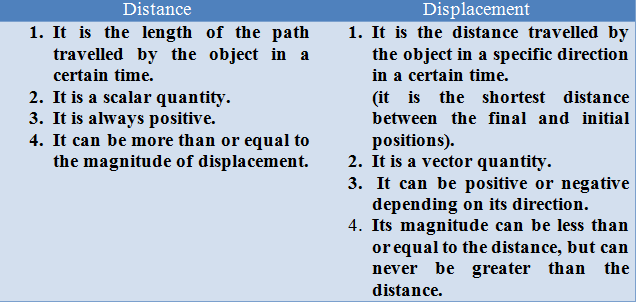Motion Class 9
Distance & Displacement
(Video lectures)
Scalar quantities or
scalars: These are physical quantities that
are expressed only by their magnitude. Examples: mass, length, time,
temperature, etc
Vector quantities or
vectors: These physical quantities require the magnitude as
well as the direction to express them. Examples: displacement, velocity, force, etc.
Rest & Motion:
A body is said to be at rest if it does not change its position with time and
with respect to its immediate surroundings, while a body is said to be in
motion if it changes its position with time and with respect to its immediate
surroundings.
Distance:
The total length of the path through which a body move is called the distance
travelled by it. The distance travelled by a body depends on the path followed
by the body. It is a scalar
quantity. It is generally represented by the letter ‘S’. The S.I unit of distance is metre (m).
Displacement: The shortest distance from the initial to the final position of the body. It is a vector quantity. It is
represented by `\vec{ S}`. The
S.I unit of displacement is metre (m).
Speed: The speed of an object is defined as the distance travelled by it per unit of time.
`v = \frac{distance}{time}` or, `v = \frac{s}{t}`
SI
unit of speed is `ms^-1`
Types of speed
- Uniform speed
- Non-uniform speed
- Average speed
1) Uniform speed:
If the moving body covers equal distances in equal intervals of time, then the
speed of the body is said to be uniform speed.
2) Non- uniform speed:
If a moving body covers unequal distances in equal intervals of time, then the
speed of the body is said to be non-uniform or variable speed.
3) Average speed Average speed of a moving body is defined as the ratio of the total distance travelled by it to the total time taken by it.
`v_{av}` = Total distance / Total time taken
Velocity: The velocity of an object is defined as the displacement of the body per unit of time.
`\vec{v} = \frac{displacement}{time}` or, `\vec{v} = \vec{s}/t`
The velocity of an object tells us how fast the object is moving and in which direction it is moving. SI unit of velocity is `ms^-1`.
Types of velocity
- Uniform velocity
- Non-uniform velocity
- Average velocity
1) Uniform velocity Velocity of an object is said to be uniform if it covers equal displacement in an equal interval of time.
2) Non- uniform velocity Velocity of an object is said to be non-uniform or variable velocity, if it covers unequal displacement in equal intervals of time.
3) Average velocity When the speed of an object changes with time along a straight line, then the average velocity of the object is
Average velocity = `(\vec{v}_{av})` = Total displacement / Total time taken
Difference between speed and velocity
 |
Rate of change of velocity (Acceleration)
👉 Acceleration 👉 The acceleration of an object is the change in velocity per unit
time.
acceleration = change in velocity/time taken
If the velocity of an object changes from an initial value `u` to the final value `v` in time `t`, the acceleration `a` is,
`a = \frac{v-u}{t}`
or
`a = \frac{\triangle v}{\triangle t}`
`u` 👉 Initial velocity
`v` 👉 Final velocity
`t` 👉 Time interval
The acceleration is taken to be positive if it is in the direction of velocity and negative when it is opposite to the direction of velocity. The SI unit of acceleration is `m s^{–2}`.
If an object travels in a straight line and its velocity increases or decreases by equal amounts in equal intervals of time, then the acceleration of the object is said to be uniform. On the other hand, an object can travel with non-uniform acceleration if its velocity changes at a non-uniform rate.
Graphical Representation of Motion
Graphs provide a convenient method to present basic information about a variety of events. For example, in the telecast of a one-day cricket match, vertical bar graphs show the run rate of a team in each over.
DISTANCE–TIME GRAPHS
The nature of the motion of an object can be studied by plotting a graph between the distance covered and time. Such a graph is called a distance-time graph.
The distance-time graph of an object moving with a uniform speed is a straight line.
Equations of Motion by Graphical Method
When an object moves along a straight line with uniform acceleration, it is possible to relate its velocity, acceleration during motion, and the distance covered by it in a certain time interval by a set of equations known as the equations of motion.
Work in progress
References
- Super Simplified Science Physics Class IX
- NCERT Science Class IX


Good notes 👌👍
ReplyDeleteThank you.
DeleteNice notes
ReplyDeleteThanks
Deletevery excellent👌👌 notes
ReplyDeleteThanks dear
Delete☺️Bhut jyada 👌 achha notes h👆👍
ReplyDeleteThis comment has been removed by the author.
ReplyDeleteThis comment has been removed by the author.
DeleteGourav kumar
ReplyDeleteThank you so much Sir because mera liye yah notes bahut jayada helpful hi. 💯💯Sir
Its 🤑 amazing 🎉 uncountable 🔥🔥🔥💫likes 💐✨✨✨✨✨✨✨✨✨💯💯💯💯💯💯💯💯
ReplyDeleteThank u sir for providing notes and video
ReplyDeleteThanks, Saurav
DeleteWaah 👆👍👍👍👍🏆
ReplyDeleteThank you so much
DeleteThank you for your understanding and patience. You're a great teacher and everything you've done means so much to me.” “Thank you all so much for the support that you've provided me with. It's been an amazing experience and has led me to consider a future career in supporting people with additional needs.👌🏻👌🏻👌🏻👌🏻👍👍👍👍
ReplyDeleteThank you so much sir very important notes dene ke liye📝
ReplyDelete